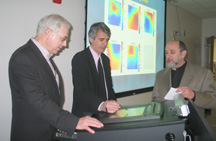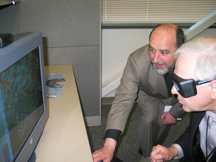The explosion in information about human genes has created an unprecedented need for scientists to use computers and achievements in information science and technology to study large amounts of information. Called bioinformatics, the relatively new discipline applies the principles and methods of information science and technology to improve patient care, medical education and health sciences research.
 |
Simon Sherman, Ph.D., right, director of the Nebraska Informatics Center for the Life Sciences, shows Don Leuenberger, left, and Ron Schaefer the SMART Sympodium in the Bioinformatics Research and Training Facility. |
The UNMC Bioinformatics Research and Training Facility recently hosted an open house at the Scott Technology Center to demonstrate its ability to provide services for life science researchers and train students in the use of bioinformatics tools. Located on the University of Nebraska at Omaha’s South Campus, the facility is an integral part of the Nebraska Informatics Center for the Life Sciences (NICLS). NICLS was established in 2001 by the Board of Regents to facilitate the integration of biocomputing/informatics disciplines with the life sciences.
NICLS is an effort to bring UNMC and the university one step closer to building an infrastructure for bioinformatics research collaboration across the state and incorporate academic research with biotechnology business initiatives in Nebraska, say officials.
Involved in the initiative are faculty from UNMC, UNO, the University of Nebraska-Lincoln and Creighton University. The universities are part of a coordinating cross-campus and statewide effort in bioinformatics, chemoinformatics, pharmaco-informatics, computational chemistry and computational biology.
Simon Sherman, Ph.D., director of the NICLS, said the site will provide expertise, service and computing resources for inter-campus research projects. It will be also the place where graduate and undergraduate students from all of the University of Nebraska campuses, as well as high-school students and students from other colleges who are involved in summer research programs, will be trained in the use of bioinformatics methods and tools.
During the open house, Dr. Sherman, a professor in the UNMC Eppley Cancer Institute, thanked several administrators for providing support for the facility. Among the officials Dr. Sherman thanked were Harold M. Maurer, M.D., UNMC chancellor, Don Leuenberger, UNMC vice chancellor of business and finance, and Kenneth Cowan, M.D. Ph.D., director of the UNMC Eppley Cancer Center, as well as other UNMC administrators and faculty.
 |
Simon Sherman, Ph.D., director of the Nebraska Informatics Center for the Life Sciences, shows Don Leuenberger, UNMC vice chancellor of business and finance, a computer molecule model through 3-D glasses. The computer models can help researchers test their hypotheses, saving time and money, Dr. Sherman said. |
“Resources provided by different grant applications have been used to build this fantastic facility,” Dr. Sherman said. “We are proud to be part of the Scott Technology Center. One of our new missions is to build a bridge between academia and industry.”
“This is going to be a fabulous facility,” said Leuenberger. “We’re happy to be here. It’s a great program.”
In one of the facility’s rooms, a 64 CPU computer cluster enables the processing of 350 billion operations per second.
“Gene sequencing takes a lot of computational power,” said Alex Nicoll, senior technology research fellow in the UNO College of Information Sciences and Technology. “One machine could take up to 30 minutes to do a single database query. With this cluster, it would take less than three minutes.”
“We are merging biology and computers. It’s a faster and more efficient way to process information. It’s kind of breaking new ground,” Nicoll said. “We take biological information and put it into a form more easily used by researchers.”
The facility also houses Oracle database and application servers, which are used for the development and hosting of disease-oriented patient registries and data warehouses. Dr. Sherman said the Pancreatic Cancer Collaborative Registry (pccr.unmc.edu) is the first registry to be established. It was created and designed to unite centers with expertise in pancreatic cancer.
Dr. Sherman and colleagues also are involved in the Infotec 2004 conference, which will run through Thursday (April 22) at Qwest Center Omaha. The conference features information about bioinformatics and some of the university’s efforts. If anyone is interested in attending the conference, titled the 31st Annual Midwest Business Technology Expo and Conference, go to www.infotech.org.
For more information about the NICLS, visit http://bioinformatics.unmc.edu .